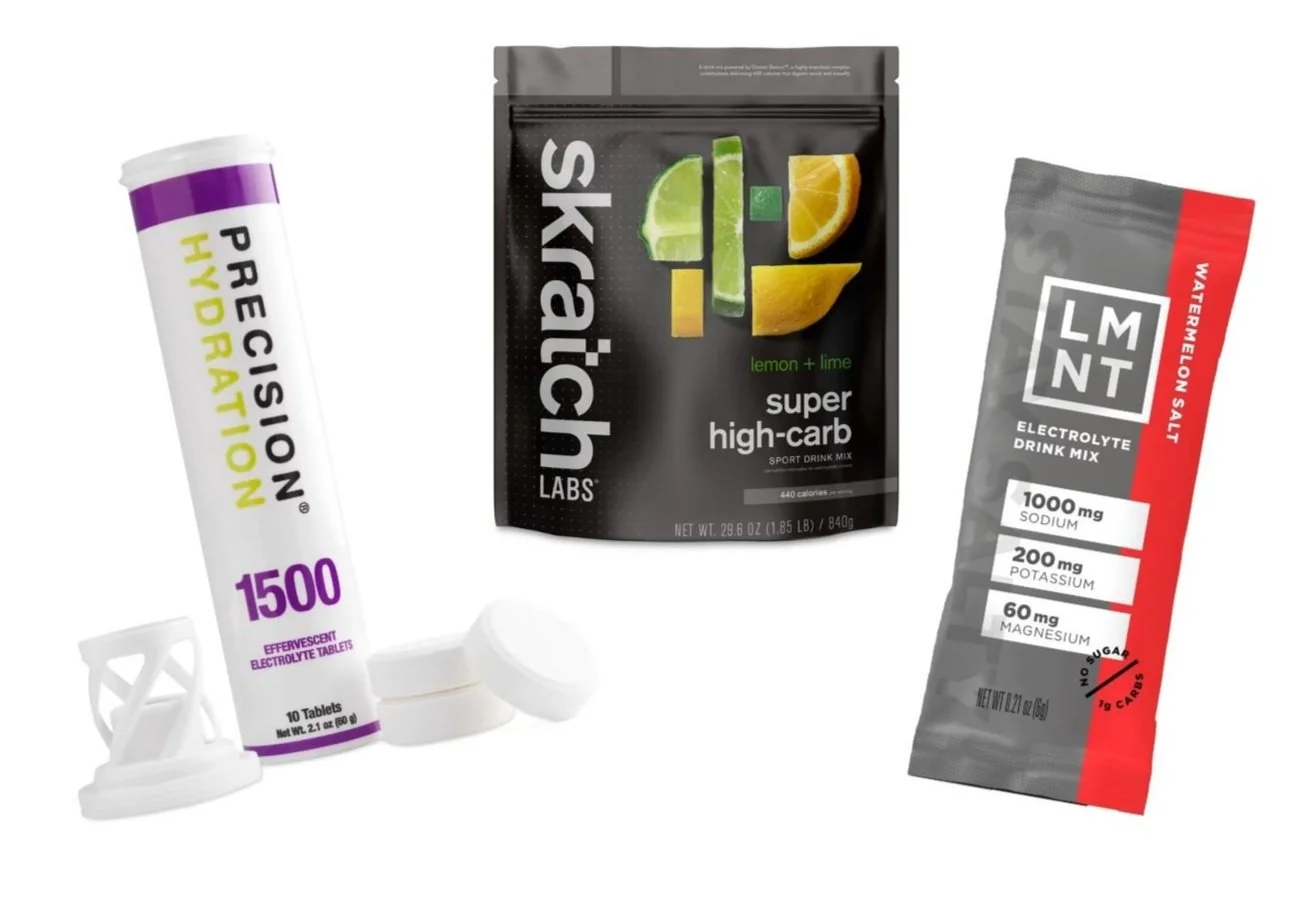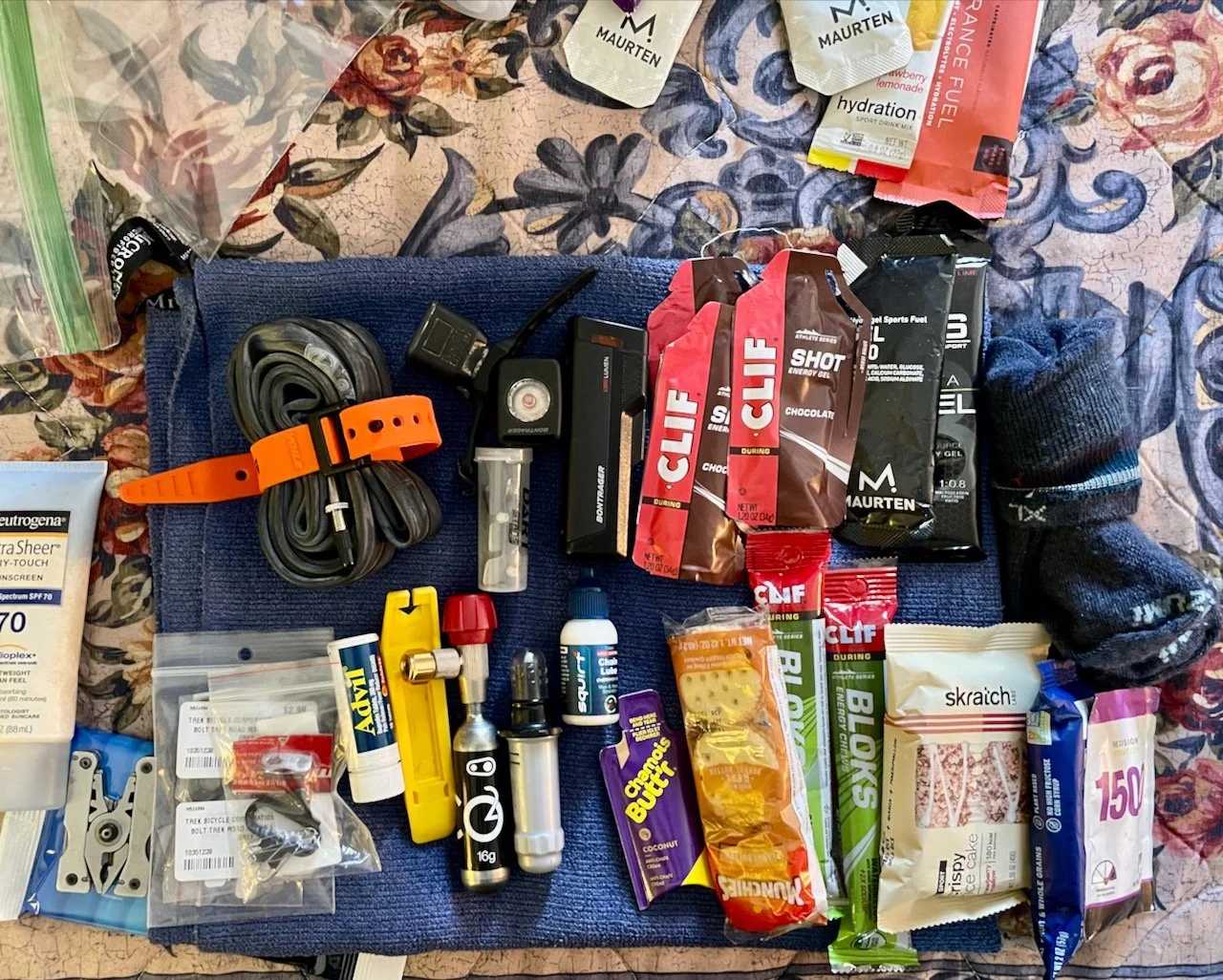Hydration for Cyclists
Learn how to hydrate for your best performance
The importance of proper hydration for exercise and general health cannot be overstated. Water plays a critical role in brain function, muscle function, digestion, temperature regulation, cardiovascular function and many other processes. For athletes, hydration status is something that should be monitored during and outside of training closely. Follow the advice below to stay hydrated and get the most out of your training.
Short Answer
For all rides, hydrate beforehand. During rides, drink regularly to replace sweat loss. For intense rides or hot or humid days, drink to a plan. This means drink at regular intervals - a few sips every 10-15min at a minimum. A bottle an hour is a common target in the warmer months, but should increase based on sweat rate. If you’re a heavy sweater or going on 4+ hour rides, add electrolyte mix to your bottle.
Hydrate beforehand: .5 - 1 bottle within an hour or two of your ride
Eating a salty snack or adding electrolyte mix will improve water retention
During your ride, drink regularly or to a plan, based on sweat rate
For sweaty rides, a bottle an hour is a good start
Most cycling bottles are 21-24oz, or 620-710ml
Longer Answer
Drinking to thirst is usually sufficient for most of the day, but exercise places a lot of demands on our body and even the slightest dehydration can affect performance. Starting exercise in this state means we are already behind on hydration and catching up can be tough, especially for intense rides or in hot or humid conditions.
Fluid needs during exercise is highly individual. Weather, activity level, individual sweat response, heat tolerance, training status, and bodyweight all play a role. Some athletes ride well drinking only half a bottle per hour (300ml) while others can tolerate 2 bottles per hour (1.5L). Just like eating too much food too quickly, drinking too much water can cause discomfort, bloating, or a sloshing around feeling in your belly.
Matching intake amount with fluid loss from sweating can be very difficult. Intense exercise in the heat can cause fluid loss 2-3 liters per hour. Drinking more than 1L per hour can be uncomfortable for many athletes, especially during a race, so pre-hydrating is an important step.
1-2 hours before your ride:
6-8ml of water per kg of bodyweight
For example: 70 kg athlete (154lb) = 420 - 560ml of water (15-19oz)
During your ride:
Highly individual and should be based on normal sweat loss in similar conditions
Use the calculation below to determine sweat loss or follow these instructions
Generally speaking, drink to a plan and consume as much as is comfortable
Added sodium can promote fluid retention and the desire to drink more
After your ride:
Replace all fluid lost to fully rehydrate or about 1.5L of water per kg of sweat loss
Just like carb intake, reaching a fluid intake goal can take practice, and even then may be hard to reach. But with diligence, we can increase our intake and improve our performance without upset stomach.
Am I Drinking Enough?
Someone with a 2% reduction in bodyweight from sweat loss is considered dehydrated. Dehydration reduces exercise performance in the following ways:
reduction in blood volume
decreased skin blood flow
decreased sweat rate
decreased heat dissipation
increased core temperature
increased rate of muscle glycogen use
That said, except in cases of heatstroke, dehydration is rarely life threatening. While it can reduce performance, as long as we rehydrate within a reasonable amount of time, we shouldn’t have any long term effects. What level of dehydration significantly reduces performance can vary from person to person, but most scientists believe that anything over 2% weight loss is a detriment and 5% can reduce performance up to 30%.
From a purely health related standpoint, drinking too much water over a short period can be more dangerous. Hyponatremia is a dangerously low sodium concentration in the bloodstream caused by drinking too much plain water too quickly. It tends to affect distance runners more than cyclists, but you can read more about it here. The point is, slamming multiple liters of water right before a ride or race is not a good idea. Plus, you’ll need to pee a lot in the first hour.
Are You Dehydrated?
Weight: Has your weight dropped quickly?
Urine: Is your urine clear or dark yellow?
Thirst: Are you thirsty?
Determining hydration status can be tricky, but if you pee several times throughout the day, you’re probably ok. The Venn diagram to the right can also help. If two of these conditions are true, you are likely dehydrated. If all three are true, you are very likely dehydrated.
Urine color should be clear to light yellow, however keep in mind that some vitamins including B2 and C can give it a dark yellow color.
If you have to pee during a ride, you’re probably hydrating well, but it’s very common to not pee at all, even on long rides. If this is the case, you’re probably not drinking enough or you’re sweating a lot or both.
One of the best ways to determine sweat loss from rides is by weighting yourself before and after. Weigh yourself naked so sweaty clothing doesn’t affect it, then subtract your post-ride weight plus the weight of all food and fluid consumed from your pre-ride weight. Then divide that number from your pre-ride weight to determine your weight loss percentage:
Pre-ride bodyweight - Post-ride bodyweight + Food/fluid consumed ÷ Pre-ride bodyweight = fluid loss percentage
Fluid loss of 2% or more is considered dehydrated. A more detailed explanation of this calculation is here.
Should I add Carbs or Hydration Mix to my Bottle?
Adding a high carbohydrate mix to water bottles can be a great way to take in water and fuel at the same time. Some carb mixes can add as much as 100g of carbs per 24oz bottle, which is a convenient way to consume small amounts regularly without having to open multiple packages, (this is about 4 gels worth of carbs).
The downside to this is, the higher the concentration of carbs in a fluid, the slower that fluid gets absorbed. This means that if hydration is a higher priority, you could be significantly slowing that process down.
Water with hydration mix on the other hand, absorbs faster than plain water. Hydration mixes like Skratch and Precision Hydration are considered isotonic because they have the same concentration of dissolved particles as blood, and therefore absorb faster than water. Products like Gatorade contain more sugar, so absorb slower like a high carb mix would. (Hydration mixes also contain some sugar as the glucose transporters in the gut help facilitate sodium and fluid absorption)
First, ask yourself what’s the highest priority during the ride overall, or in a given moment if you have both choices on board. If the ride is going to be very hot and you’ll sweat a lot, hydration should be prioritized. If sweating is minimal to moderate, then perhaps fueling can be prioritized.
Having both plain water or hydration drink as well as high carb drink with you, allows you to make this choice in the moment, based on conditions and intensity. Again, like all of these choices, practice this in training, not during an event.
If you’re unsure how to answer these questions before you ride, the safest advice is to eat your carbs and drink your hydration.
What Eric Drinks
For rides up to 2 hours I’ll drink water. For longer rides, I’ll often have one bottle of hydration mix and one bottle of water. The plain water is nice to have when you’re tired of flavoring or its aftertaste.
Contents of one drop bag from Unbound 200
For races up to 3 hours, I’ll often drink hydration mix, light carb mix, or both. It really depends on conditions and intensity and the ease of eating. For very long days or ultra-races on the road or gravel I’ll start with 1 to 2 bottles of high carb mix and then a small vest style hydration pack with only water. For big events the rest stops won’t have high carb mixes, but if the race offers drop bags I’ll include pre-measured carb mix in ziplocks to replenish bottles. (Long races often allow one or more drop bags of your own food and equipment that they will transport to and from the aid stations. You should always take advantage of this service.)
For any mountain bike races longer than 2 hours, I’ll use a hydration pack for water and tools, and maybe a bottle with carb or hydration mix. Big events like the Leadville 100 will have drop bag service and aid stations. For shorter MTB races, I’ll go extra light with only a bottle of water or hydration mix. Since these races tend to have multiple laps, you can switch out bottles or take hand-ups from friends or family as you go through the start/finish. For fuel, I’ll usually have a gel right before and once during the race.
I experiment a lot. Anytime I can order samples or just try something new, I’ll buy it and see how I like it in training. Sometimes I’ll mix carb powder and hydration powder in the same bottle. You can get really creative — it’s just a matter of what you can tolerate and how it tastes. Right now my goal is to find prepackaged energy food that’s savory. The constant sugar can cause palate fatigue on long rides. Homemade things like rice cakes from The Feed Zone Portables book are very good, but take planning to make and aren’t super easy to eat with one hand while pedaling.




